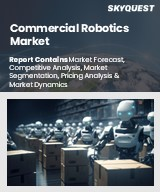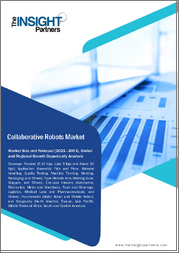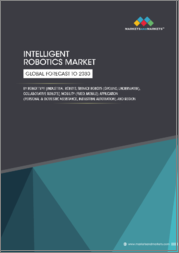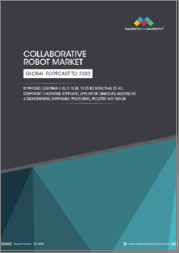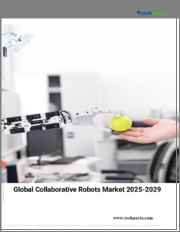
|
시장보고서
상품코드
1600632
협동 로봇 시장 : 기능, 적재량, 컴포넌트, 산업, 용도별 - 세계 예측(2025-2030년)Collaborative Robots Market by Function (Hand Guiding, Power & Force Limiting, Safety-Rated Monitored Stop), Payload Capacity (Above 10kg, Between 5 & 10kg, Up to 5 Kg), Component, Industry, Application - Global Forecast 2025-2030 |
||||||
협동 로봇 시장은 2023년에 23억 8,000만 달러로 평가되며, 2024년에는 34억 3,000만 달러에 달할 것으로 예측되며, CAGR 46.37%로 성장하며, 2030년에는 343억 6,000만 달러에 달할 것으로 예측됩니다.
협동 로봇, 즉 코봇은 다양한 산업에서 생산성과 안전성을 높이고 인간과 함께 작업하도록 설계된 자동화의 한 분야입니다. 코봇의 필요성은 인간 노동자를 대체하는 것이 아니라 보완하는 유연하고 효율적인 자동화 솔루션에 대한 수요가 증가함에 따라 생겨났습니다. 이러한 로봇은 제조, 물류, 의료, 농업 등의 분야에서 점점 더 많이 적용되고 있으며, 인간과 안전하게 상호 작용하고 협업할 수 있는 능력으로 인해 업무 효율성이 크게 향상되고 있습니다. 최종 사용 범위 측면에서 코봇은 조립, 기계 조작, 포장부터 품질 검사 및 정밀 작업의 보다 복잡한 역할에 이르기까지 다양한 작업에서 유용하게 사용되고 있습니다. 주요 성장 요인으로는 코봇의 안전성과 반응성을 높여주는 센서 기술의 발전과 스마트 제조 솔루션을 중시하는 인더스트리 4.0 동향 증가를 꼽을 수 있습니다. 이러한 유망한 신흥 국가 시장 개척에도 불구하고 높은 선행 비용, 기술 통합의 어려움, 규제 대응 등의 과제가 시장 확대의 걸림돌로 작용하고 있습니다. 또한 많은 기업이 이 기술을 효과적으로 활용하는 데 있으며, 기술 격차에 직면해 있습니다. 이러한 문제를 기회로 전환하기 위해 기업은 통합 용이성, 사용자 친화적인 인터페이스, 향상된 안전 기능을 갖춘 코봇 개발에 집중할 수 있으며, AI와 머신러닝의 혁신은 다양한 작업 환경에 더 스마트하게 적응할 수 있는 코봇을 만들 수 있는 잠재력을 가지고 있습니다. 인간과 기계의 상호 작용 개선 및 협업 알고리즘과 같은 연구 분야는 여전히 탐구할 만한 가치가 있는 분야입니다. 시장 관계자들은 중소기업에서 코봇 도입의 효과를 강조하고, 적용 범위와 시장 침투를 확대하기 위한 파트너십과 교육 프로그램에 투자해야 합니다. 협동 로봇 시장의 특성은 역동적이며, 끊임없는 기술 혁신과 경제 수요의 변화로 인해 비즈니스 성공을 위해서는 전략 수립에 있으며, 민첩성과 선견지명이 필요합니다. 따라서 새로운 시장 기회를 개척하기 위해서는 내재된 제약을 극복하고 새로운 시장 기회를 개척하기 위한 연구와 유연한 채택 전략이 필수적입니다.
| 주요 시장 통계 | |
|---|---|
| 기준년[2023년] | 23억 8,000만 달러 |
| 예측년[2024년] | 34억 3,000만 달러 |
| 예측년[2030년] | 343억 6,000만 달러 |
| CAGR(%) | 46.37% |
시장 역학: 빠르게 진화하는 협동 로봇 시장의 주요 시장 인사이트 공개
협동로봇 시장은 수요 및 공급의 역동적인 상호작용에 의해 변화하고 있습니다. 이러한 시장 역학의 진화를 이해함으로써 기업은 정보에 입각한 투자 결정, 전략적 의사결정, 새로운 비즈니스 기회를 포착할 수 있습니다. 이러한 동향을 종합적으로 파악함으로써 기업은 정치적, 지역적, 기술적, 사회적, 경제적 영역에 걸친 다양한 리스크를 완화하고, 소비자 행동과 그것이 제조 비용 및 구매 동향에 미치는 영향을 보다 명확하게 이해할 수 있습니다.
- 시장 성장 촉진요인
- 자동화, 높은 처리율, 고정밀화로 인한 수요 증가
- 자동화 및 모바일 로봇에 대한 산업계의 열의가 높아지고 있습니다.
- 저렴한 가격과 높은 ROI를 통한 중소기업 보급
- 인간 행동을 모방하기 위한 AI의 통합과 인간-기계 인터페이스(HMI)의 개선이 증가하고 있습니다.
- 시장 성장 억제요인
- 안전성, 사이클 타임 단축, 재현성 관련 능력의 한계
- 자본 집약적 협동 로봇
- 시장 기회
- 차세대 코봇의 기술 혁신
- 제조 및 산업 현장 채택 확대
- 시장 과제
- 대량 도입 관련 과제
- 인간과 안전하게 작업할 수 있는 더 나은 의사결정 개발
Porter's Five Forces: 협동로봇 시장 공략을 위한 전략적 툴
Porter's Five Forces 프레임워크는 시장 상황경쟁 구도를 이해하는 데 중요한 툴입니다. Porter의 Five Forces 프레임워크는 기업의 경쟁을 평가하고 전략적 기회를 모색하기 위한 명확한 방법을 설명합니다. 이 프레임워크는 기업이 시장내 세력도를 평가하고 신규 사업의 수익성을 판단하는 데 도움이 됩니다. 이러한 인사이트을 통해 기업은 강점을 활용하고 약점을 보완하며 잠재적인 도전을 피함으로써 보다 강력한 시장 지위를 확보할 수 있습니다.
PESTLE 분석 : 협동로봇 시장의 외부 영향력 파악
외부 거시 환경 요인은 협동로봇 시장의 성과 역학을 형성하는 데 매우 중요한 역할을 합니다. 정치적, 경제적, 사회적, 기술적, 법적, 환경적 요인에 대한 분석은 이러한 영향을 탐색하는 데 필요한 정보를 담고 있으며, PESTLE 요인을 조사함으로써 기업은 잠재적인 위험과 기회를 더 잘 이해할 수 있습니다. 이러한 분석을 통해 기업은 규제, 소비자 선호도, 경제 동향의 변화를 예측하고 선제적이고 적극적인 의사결정을 내릴 준비를 할 수 있습니다.
시장 점유율 분석 : 협동로봇 시장 경쟁상황 파악
협동 로봇 시장의 상세한 시장 점유율 분석을 통해 공급업체의 성과를 종합적으로 평가할 수 있습니다. 기업은 매출, 고객 기반, 성장률 등 주요 지표를 비교하여 경쟁적 포지셔닝을 파악할 수 있습니다. 이 분석은 시장의 집중화, 세분화 및 통합 추세를 파악하여 공급업체가 치열한 경쟁에서 자신의 입지를 강화할 수 있는 전략적 의사결정을 내리는 데 필요한 인사이트을 제공합니다.
FPNV 포지셔닝 매트릭스: 협동로봇 시장에서공급업체 성과 평가
FPNV 포지셔닝 매트릭스는 협동로봇 시장에서 공급업체를 평가하는 중요한 툴입니다. 이 매트릭스를 통해 비즈니스 조직은 벤더의 비즈니스 전략과 제품 만족도를 기반으로 평가하여 목표에 부합하는 정보에 입각한 의사결정을 내릴 수 있으며, 4개의 사분면은 벤더를 명확하고 정확하게 구분하여 사용자가 전략적에 가장 적합한 파트너와 솔루션을 식별할 수 있도록 도와줍니다. 식별할 수 있도록 도와줍니다.
이 보고서는 주요 관심 부문에 대한 종합적인 시장 분석을 제공합니다.
1. 시장 침투도 : 업계 주요 기업의 광범위한 데이터를 포함한 현재 시장 환경에 대한 상세한 검토.
2. 시장 개척도: 신흥 시장에서의 성장 기회를 파악하고, 기존 부문의 확장 가능성을 평가하며, 미래 성장을 위한 전략적 로드맵을 기술하고 있습니다.
3. 시장 다각화 : 최근 제품 출시, 미개척 지역, 산업의 주요 발전, 시장을 형성하는 전략적 투자를 분석합니다.
4. 경쟁 평가 및 정보 : 경쟁 구도를 철저히 분석하여 시장 점유율, 사업 전략, 제품 포트폴리오, 인증, 규제 당국의 승인, 특허 동향, 주요 기업의 기술 발전 등을 검토합니다.
5. 제품 개발 및 혁신 : 미래 시장 성장을 가속할 것으로 예상되는 첨단 기술, 연구개발 활동 및 제품 혁신을 강조합니다.
또한 이해관계자들이 충분한 정보를 바탕으로 의사결정을 내릴 수 있도록 중요한 질문에 대한 답변도 제공합니다.
1. 현재 시장 규모와 향후 성장 전망은?
2. 최고의 투자 기회를 제공하는 제품, 지역은?
3. 시장을 형성하는 주요 기술 동향과 규제의 영향은?
4. 주요 벤더 시장 점유율과 경쟁 포지션은?
5.벤더 시장 진입 및 철수 전략의 원동력이 되는 수입원과 전략적 기회는 무엇인가?
목차
제1장 서문
제2장 조사 방법
제3장 개요
제4장 시장 개요
제5장 시장 인사이트
- 시장 역학
- 성장 촉진요인
- 성장 억제요인
- 기회
- 과제
- 시장 세분화 분석
- Porter's Five Forces 분석
- PESTEL 분석
- 정치
- 경제
- 사회
- 기술
- 법률
- 환경
제6장 협동 로봇 시장 : 기능별
- 서론
- 핸드 가이드
- 파워와 힘 제한
- 안전 평가 모니터링 정지
- 속도 저하와 차간거리 모니터링
제7장 협동 로봇 시장 : 적재량별
- 서론
- 10kg 이상
- 5-10kg
- 5kg 이하
제8장 협동 로봇 시장 : 컴포넌트별
- 서론
- 하드웨어
- 컨트롤러
- 드라이브
- 엔드 이펙터
- 센서
- 소프트웨어
제9장 협동 로봇 시장 : 산업별
- 서론
- 자동차
- 일렉트로닉스
- 식품 및 음료
- 가구·설비
- 의료
- 금속과 기계 가공
- 플라스틱과 폴리머
제10장 협동 로봇 시장 : 용도별
- 서론
- 조립
- 접착과 용접
- 기계에 의한 관리
- 자재관리
- 포장과 팔레타이징
- 픽 앤드 플레이스
- 품질 테스트
제11장 아메리카의 협동 로봇 시장
- 서론
- 아르헨티나
- 브라질
- 캐나다
- 멕시코
- 미국
제12장 아시아태평양의 협동 로봇 시장
- 서론
- 호주
- 중국
- 인도
- 인도네시아
- 일본
- 말레이시아
- 필리핀
- 싱가포르
- 한국
- 대만
- 태국
- 베트남
제13장 유럽, 중동 및 아프리카 협동 로봇 시장
- 서론
- 덴마크
- 이집트
- 핀란드
- 프랑스
- 독일
- 이스라엘
- 이탈리아
- 네덜란드
- 나이지리아
- 노르웨이
- 폴란드
- 카타르
- 러시아
- 사우디아라비아
- 남아프리카공화국
- 스페인
- 스웨덴
- 스위스
- 터키
- 아랍에미리트
- 영국
제14장 경쟁 구도
- 시장 점유율 분석, 2023년
- FPNV 포지셔닝 매트릭스, 2023년
- 경쟁 시나리오 분석
기업 리스트
- MABI Robotic AG
- MRK-Systeme GmbH
- Neura Robotics GmbH
- Epson America, Inc.
- Edgewater Automation, LLC
- Techman Robot Inc.
- Locus Robotics Corporation
- Hanwha Corporation
- Kawasaki Heavy Industries, Ltd.
- Universal Robots A/S
- Kassow Robots ApS
- F&P Robotics AG
- Rethink Robotics GmbH by HAHN Group
- DENSO WAVE INCORPORATED.
- Yaskawa Electric Corporation
- Kuka AG
- Comau S.p.A.
- Productive Robotics, LLC
- Elephant Robotics
- AutoGuide Mobile Robots
- Shenzhen Yuejiang Technology Co., Ltd.
- ONExia Inc.
- Staubli International AG
- Fanuc Corporation
- Demaurex SA
- Aubo(Beijing) Robotics Technology Co., Ltd
- Telefonaktiebolaget LM Ericsson
- Robert Bosch GmbH
- Suzhou Elite Robot Co., Ltd.
- Kawada Robotics Corporation
- JAKA Robotics Co., Ltd.
- Doosan Robotics Inc.
- PROMATION INC.
- ABB Ltd.
- Franka Emika GMBH by Agile Robots AG
The Collaborative Robots Market was valued at USD 2.38 billion in 2023, expected to reach USD 3.43 billion in 2024, and is projected to grow at a CAGR of 46.37%, to USD 34.36 billion by 2030.
Collaborative robots, or cobots, represent a segment of automation designed to work alongside humans, enhancing productivity and safety across various industries. The necessity for cobots arises from the growing demand for flexible and efficient automation solutions that complement human workers rather than replace them. These robots are increasingly applied in sectors such as manufacturing, logistics, healthcare, and agriculture, where their ability to safely interact and collaborate with human counterparts significantly enhances operational efficiency. In terms of end-use scope, cobots are valuable in tasks ranging from assembly, machine tending, and packaging to more complex roles in quality inspection and precision operations. Key growth factors include advancements in sensor technology, which enhance the safety and responsiveness of cobots, and the rising trend of Industry 4.0, which emphasizes smart manufacturing solutions. Despite these promising developments, challenges such as high upfront costs, technical integration difficulties, and regulatory compliance represent barriers to market expansion. Furthermore, many businesses face a skills gap in leveraging this technology effectively. To convert these challenges into opportunities, businesses could focus on developing cobots with improved ease of integration, user-friendly interfaces, and enhanced safety features. Innovations in AI and machine learning also hold potential for creating cobots that adapt more intelligently to diverse working environments. Research areas such as improved human-machine interaction and collaborative algorithms remain ripe for exploration. Market players should invest in partnerships and training programs that emphasize cobot implementation effectiveness in SMEs, broadening application scope and market penetration. The nature of the collaborative robot market is dynamic, driven by continuous technological innovations and shifting economic demands that necessitate agility and foresight in strategy formulation for business success. Therefore, keeping ahead with research and flexible adoption strategies will be vital for tapping into emerging market opportunities while navigating inherent limitations.
| KEY MARKET STATISTICS | |
|---|---|
| Base Year [2023] | USD 2.38 billion |
| Estimated Year [2024] | USD 3.43 billion |
| Forecast Year [2030] | USD 34.36 billion |
| CAGR (%) | 46.37% |
Market Dynamics: Unveiling Key Market Insights in the Rapidly Evolving Collaborative Robots Market
The Collaborative Robots Market is undergoing transformative changes driven by a dynamic interplay of supply and demand factors. Understanding these evolving market dynamics prepares business organizations to make informed investment decisions, refine strategic decisions, and seize new opportunities. By gaining a comprehensive view of these trends, business organizations can mitigate various risks across political, geographic, technical, social, and economic domains while also gaining a clearer understanding of consumer behavior and its impact on manufacturing costs and purchasing trends.
- Market Drivers
- Growing Demand Attributed to Automation, Higher Throughout and Better Accuracy
- Increasing Penchant of Industries toward Automation and Mobile Cobots
- Adoption Among SMEs due to Low Price Coupled with High RoI
- Rising Integration of AI and Improvement in the Human-Machine Interface (HMI) to Imitate Human Behavior
- Market Restraints
- Capability Limitations Related to Safety, Faster Cycle Time and Repeatability
- Capital Intensive Collaborative Robots
- Market Opportunities
- Technological Innovations in the Next-Generation Cobots
- Increasing Adoption in Manufacturing and Industrial Settings
- Market Challenges
- Issues Related to Massive Deployment
- Developing Better Decision Making to Work Safely with Human
Porter's Five Forces: A Strategic Tool for Navigating the Collaborative Robots Market
Porter's five forces framework is a critical tool for understanding the competitive landscape of the Collaborative Robots Market. It offers business organizations with a clear methodology for evaluating their competitive positioning and exploring strategic opportunities. This framework helps businesses assess the power dynamics within the market and determine the profitability of new ventures. With these insights, business organizations can leverage their strengths, address weaknesses, and avoid potential challenges, ensuring a more resilient market positioning.
PESTLE Analysis: Navigating External Influences in the Collaborative Robots Market
External macro-environmental factors play a pivotal role in shaping the performance dynamics of the Collaborative Robots Market. Political, Economic, Social, Technological, Legal, and Environmental factors analysis provides the necessary information to navigate these influences. By examining PESTLE factors, businesses can better understand potential risks and opportunities. This analysis enables business organizations to anticipate changes in regulations, consumer preferences, and economic trends, ensuring they are prepared to make proactive, forward-thinking decisions.
Market Share Analysis: Understanding the Competitive Landscape in the Collaborative Robots Market
A detailed market share analysis in the Collaborative Robots Market provides a comprehensive assessment of vendors' performance. Companies can identify their competitive positioning by comparing key metrics, including revenue, customer base, and growth rates. This analysis highlights market concentration, fragmentation, and trends in consolidation, offering vendors the insights required to make strategic decisions that enhance their position in an increasingly competitive landscape.
FPNV Positioning Matrix: Evaluating Vendors' Performance in the Collaborative Robots Market
The Forefront, Pathfinder, Niche, Vital (FPNV) Positioning Matrix is a critical tool for evaluating vendors within the Collaborative Robots Market. This matrix enables business organizations to make well-informed decisions that align with their goals by assessing vendors based on their business strategy and product satisfaction. The four quadrants provide a clear and precise segmentation of vendors, helping users identify the right partners and solutions that best fit their strategic objectives.
Key Company Profiles
The report delves into recent significant developments in the Collaborative Robots Market, highlighting leading vendors and their innovative profiles. These include MABI Robotic AG, MRK-Systeme GmbH, Neura Robotics GmbH, Epson America, Inc., Edgewater Automation, LLC, Techman Robot Inc., Locus Robotics Corporation, Hanwha Corporation, Kawasaki Heavy Industries, Ltd., Universal Robots A/S, Kassow Robots ApS, F&P Robotics AG, Rethink Robotics GmbH by HAHN Group, DENSO WAVE INCORPORATED., Yaskawa Electric Corporation, Kuka AG, Comau S.p.A., Productive Robotics, LLC, Elephant Robotics, AutoGuide Mobile Robots, Shenzhen Yuejiang Technology Co., Ltd., ONExia Inc., Staubli International AG, Fanuc Corporation, Demaurex SA, Aubo (Beijing) Robotics Technology Co., Ltd, Telefonaktiebolaget LM Ericsson, Robert Bosch GmbH, Suzhou Elite Robot Co., Ltd., Kawada Robotics Corporation, JAKA Robotics Co., Ltd., Doosan Robotics Inc., PROMATION INC., ABB Ltd., and Franka Emika GMBH by Agile Robots AG.
Market Segmentation & Coverage
This research report categorizes the Collaborative Robots Market to forecast the revenues and analyze trends in each of the following sub-markets:
- Based on Function, market is studied across Hand Guiding, Power & Force Limiting, Safety-Rated Monitored Stop, and Speed Reduction & Separation Monitoring.
- Based on Payload Capacity, market is studied across Above 10kg, Between 5 & 10kg, and Up to 5 Kg.
- Based on Component, market is studied across Hardware and Software. The Hardware is further studied across Controller, Drive, End Effector, and Sensor.
- Based on Industry, market is studied across Automotive, Electronics, Food & Beverages, Furniture & Equipment, Healthcare, Metals & Machining, and Plastics & Polymers.
- Based on Application, market is studied across Assembly, Gluing & Welding, Machine Tending, Material Handling, Packaging & Palletizing, Pick & Place, and Quality Testing.
- Based on Region, market is studied across Americas, Asia-Pacific, and Europe, Middle East & Africa. The Americas is further studied across Argentina, Brazil, Canada, Mexico, and United States. The United States is further studied across California, Florida, Illinois, New York, Ohio, Pennsylvania, and Texas. The Asia-Pacific is further studied across Australia, China, India, Indonesia, Japan, Malaysia, Philippines, Singapore, South Korea, Taiwan, Thailand, and Vietnam. The Europe, Middle East & Africa is further studied across Denmark, Egypt, Finland, France, Germany, Israel, Italy, Netherlands, Nigeria, Norway, Poland, Qatar, Russia, Saudi Arabia, South Africa, Spain, Sweden, Switzerland, Turkey, United Arab Emirates, and United Kingdom.
The report offers a comprehensive analysis of the market, covering key focus areas:
1. Market Penetration: A detailed review of the current market environment, including extensive data from top industry players, evaluating their market reach and overall influence.
2. Market Development: Identifies growth opportunities in emerging markets and assesses expansion potential in established sectors, providing a strategic roadmap for future growth.
3. Market Diversification: Analyzes recent product launches, untapped geographic regions, major industry advancements, and strategic investments reshaping the market.
4. Competitive Assessment & Intelligence: Provides a thorough analysis of the competitive landscape, examining market share, business strategies, product portfolios, certifications, regulatory approvals, patent trends, and technological advancements of key players.
5. Product Development & Innovation: Highlights cutting-edge technologies, R&D activities, and product innovations expected to drive future market growth.
The report also answers critical questions to aid stakeholders in making informed decisions:
1. What is the current market size, and what is the forecasted growth?
2. Which products, segments, and regions offer the best investment opportunities?
3. What are the key technology trends and regulatory influences shaping the market?
4. How do leading vendors rank in terms of market share and competitive positioning?
5. What revenue sources and strategic opportunities drive vendors' market entry or exit strategies?
Table of Contents
1. Preface
- 1.1. Objectives of the Study
- 1.2. Market Segmentation & Coverage
- 1.3. Years Considered for the Study
- 1.4. Currency & Pricing
- 1.5. Language
- 1.6. Stakeholders
2. Research Methodology
- 2.1. Define: Research Objective
- 2.2. Determine: Research Design
- 2.3. Prepare: Research Instrument
- 2.4. Collect: Data Source
- 2.5. Analyze: Data Interpretation
- 2.6. Formulate: Data Verification
- 2.7. Publish: Research Report
- 2.8. Repeat: Report Update
3. Executive Summary
4. Market Overview
5. Market Insights
- 5.1. Market Dynamics
- 5.1.1. Drivers
- 5.1.1.1. Growing Demand Attributed to Automation, Higher Throughout and Better Accuracy
- 5.1.1.2. Increasing Penchant of Industries toward Automation and Mobile Cobots
- 5.1.1.3. Adoption Among SMEs due to Low Price Coupled with High RoI
- 5.1.1.4. Rising Integration of AI and Improvement in the Human-Machine Interface (HMI) to Imitate Human Behavior
- 5.1.2. Restraints
- 5.1.2.1. Capability Limitations Related to Safety, Faster Cycle Time and Repeatability
- 5.1.2.2. Capital Intensive Collaborative Robots
- 5.1.3. Opportunities
- 5.1.3.1. Technological Innovations in the Next-Generation Cobots
- 5.1.3.2. Increasing Adoption in Manufacturing and Industrial Settings
- 5.1.4. Challenges
- 5.1.4.1. Issues Related to Massive Deployment
- 5.1.4.2. Developing Better Decision Making to Work Safely with Human
- 5.1.1. Drivers
- 5.2. Market Segmentation Analysis
- 5.2.1. Function: Increasing usage of power & force limiting function of collaborative robots
- 5.2.2. Component: Rising usage of hardware components in collaborative robots
- 5.2.3. Industry: Growing demand for collaborative robots from the automotive industry for assembling, welding, and painting.
- 5.2.4. Application: Expanding application of collaborative robots for packaging & palletizing
- 5.3. Porter's Five Forces Analysis
- 5.3.1. Threat of New Entrants
- 5.3.2. Threat of Substitutes
- 5.3.3. Bargaining Power of Customers
- 5.3.4. Bargaining Power of Suppliers
- 5.3.5. Industry Rivalry
- 5.4. PESTLE Analysis
- 5.4.1. Political
- 5.4.2. Economic
- 5.4.3. Social
- 5.4.4. Technological
- 5.4.5. Legal
- 5.4.6. Environmental
- 5.5. Client Customization
- 5.5.1. Value Chain Analysis
6. Collaborative Robots Market, by Function
- 6.1. Introduction
- 6.2. Hand Guiding
- 6.3. Power & Force Limiting
- 6.4. Safety-Rated Monitored Stop
- 6.5. Speed Reduction & Separation Monitoring
7. Collaborative Robots Market, by Payload Capacity
- 7.1. Introduction
- 7.2. Above 10kg
- 7.3. Between 5 & 10kg
- 7.4. Up to 5 Kg
8. Collaborative Robots Market, by Component
- 8.1. Introduction
- 8.2. Hardware
- 8.2.1. Controller
- 8.2.2. Drive
- 8.2.3. End Effector
- 8.2.4. Sensor
- 8.3. Software
9. Collaborative Robots Market, by Industry
- 9.1. Introduction
- 9.2. Automotive
- 9.3. Electronics
- 9.4. Food & Beverages
- 9.5. Furniture & Equipment
- 9.6. Healthcare
- 9.7. Metals & Machining
- 9.8. Plastics & Polymers
10. Collaborative Robots Market, by Application
- 10.1. Introduction
- 10.2. Assembly
- 10.3. Gluing & Welding
- 10.4. Machine Tending
- 10.5. Material Handling
- 10.6. Packaging & Palletizing
- 10.7. Pick & Place
- 10.8. Quality Testing
11. Americas Collaborative Robots Market
- 11.1. Introduction
- 11.2. Argentina
- 11.3. Brazil
- 11.4. Canada
- 11.5. Mexico
- 11.6. United States
12. Asia-Pacific Collaborative Robots Market
- 12.1. Introduction
- 12.2. Australia
- 12.3. China
- 12.4. India
- 12.5. Indonesia
- 12.6. Japan
- 12.7. Malaysia
- 12.8. Philippines
- 12.9. Singapore
- 12.10. South Korea
- 12.11. Taiwan
- 12.12. Thailand
- 12.13. Vietnam
13. Europe, Middle East & Africa Collaborative Robots Market
- 13.1. Introduction
- 13.2. Denmark
- 13.3. Egypt
- 13.4. Finland
- 13.5. France
- 13.6. Germany
- 13.7. Israel
- 13.8. Italy
- 13.9. Netherlands
- 13.10. Nigeria
- 13.11. Norway
- 13.12. Poland
- 13.13. Qatar
- 13.14. Russia
- 13.15. Saudi Arabia
- 13.16. South Africa
- 13.17. Spain
- 13.18. Sweden
- 13.19. Switzerland
- 13.20. Turkey
- 13.21. United Arab Emirates
- 13.22. United Kingdom
14. Competitive Landscape
- 14.1. Market Share Analysis, 2023
- 14.2. FPNV Positioning Matrix, 2023
- 14.3. Competitive Scenario Analysis
- 14.3.1. Universal Robots continues its innovation journey by launching new 30 kg collaborative robot
- 14.3.2. Agile Robots acquires Franka Emika
- 14.3.3. South Korea's Doosan Robotics opens books for USD 318 million IPO
- 14.3.4. Doosan Robotics Launches Nsf-Certified E-Series Line Of Cobots, Dedicated Collaborative Robots For The Food & Beverage Industry
Companies Mentioned
- 1. MABI Robotic AG
- 2. MRK-Systeme GmbH
- 3. Neura Robotics GmbH
- 4. Epson America, Inc.
- 5. Edgewater Automation, LLC
- 6. Techman Robot Inc.
- 7. Locus Robotics Corporation
- 8. Hanwha Corporation
- 9. Kawasaki Heavy Industries, Ltd.
- 10. Universal Robots A/S
- 11. Kassow Robots ApS
- 12. F&P Robotics AG
- 13. Rethink Robotics GmbH by HAHN Group
- 14. DENSO WAVE INCORPORATED.
- 15. Yaskawa Electric Corporation
- 16. Kuka AG
- 17. Comau S.p.A.
- 18. Productive Robotics, LLC
- 19. Elephant Robotics
- 20. AutoGuide Mobile Robots
- 21. Shenzhen Yuejiang Technology Co., Ltd.
- 22. ONExia Inc.
- 23. Staubli International AG
- 24. Fanuc Corporation
- 25. Demaurex SA
- 26. Aubo (Beijing) Robotics Technology Co., Ltd
- 27. Telefonaktiebolaget LM Ericsson
- 28. Robert Bosch GmbH
- 29. Suzhou Elite Robot Co., Ltd.
- 30. Kawada Robotics Corporation
- 31. JAKA Robotics Co., Ltd.
- 32. Doosan Robotics Inc.
- 33. PROMATION INC.
- 34. ABB Ltd.
- 35. Franka Emika GMBH by Agile Robots AG






